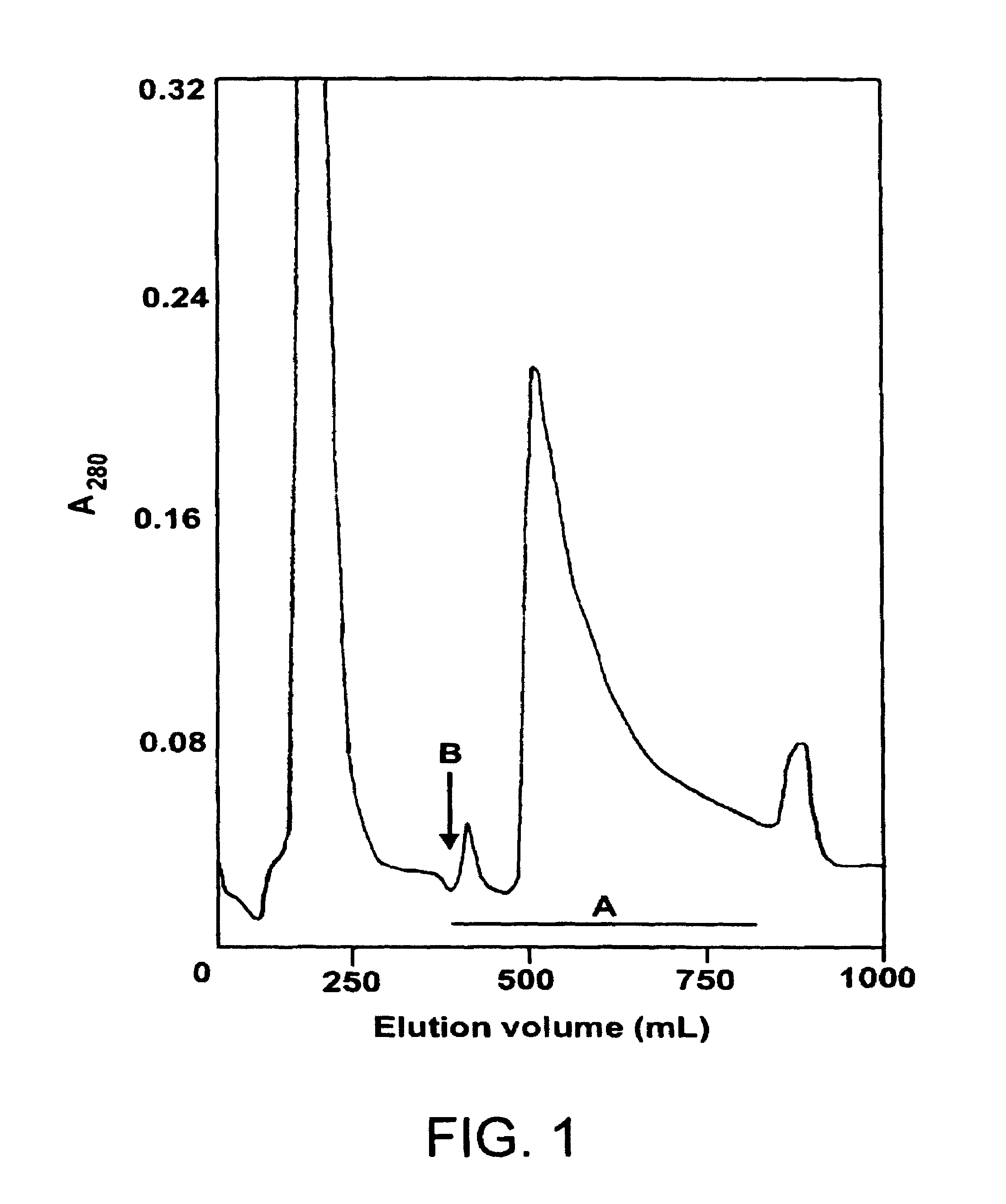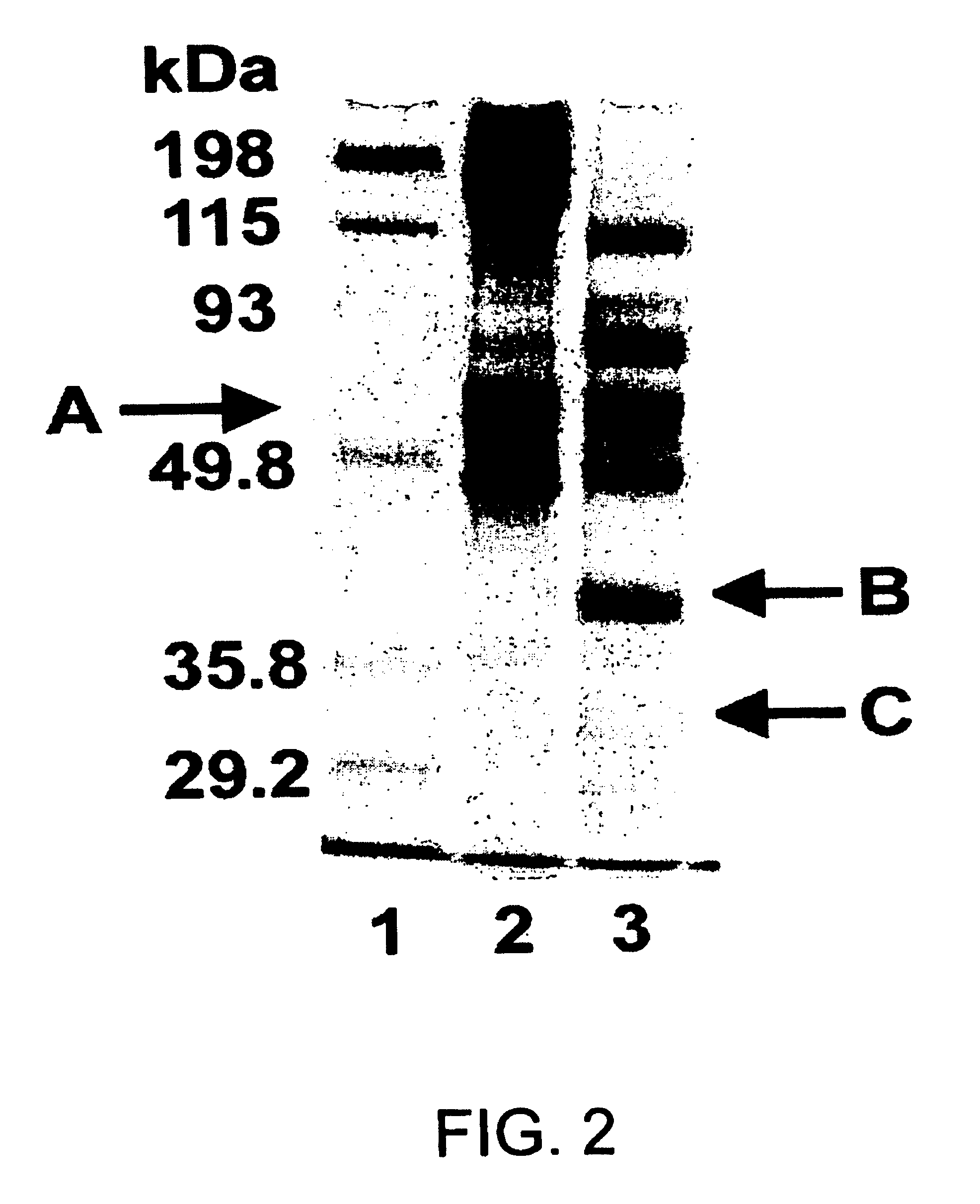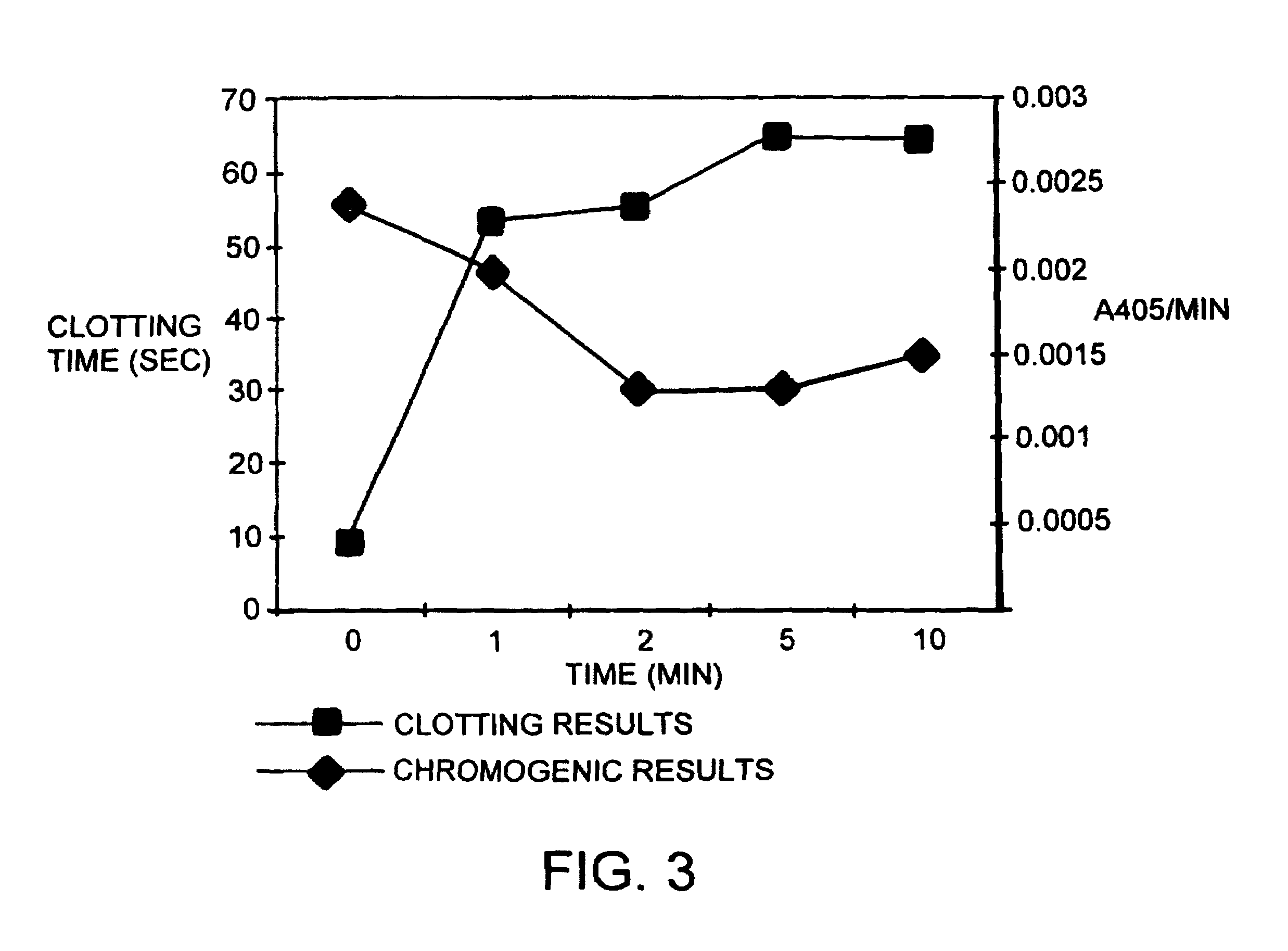[0010]The invention is based, in part, on the discovery of prothrombin activating polypeptides, referred to herein as “snake
venom proteases or SVP's,” which are factor independent. The snake venom proteases share certain
amino acid sequences similarity to the
amino acid sequences of factor Xa and trocarin which are prothrombin activators that require
calcium, phospholipids and factor Va for activation. However, the snake venom proteases of the invention are complete or partially complete prothrombin activators and thus do not have the
cofactor requirements of human factor Xa or trocarin. In other words, they can process prothrombin to
thrombin in the absence of cofactors such as
calcium, phospholipids and / or factor Va. For example, snake venom proteases from brown, coastal taipan and inland taipan venom are complete prothrombin factors in that they can process prothrombin to
thrombin in the absence of
calcium, phospholipids and factor Va. These SVP's appear to include an internal domain, residues 292-305 of FIG. 23, which makes them independent of host supplied Factor Va.
Snake venom proteases from, for example, red belly, tiger and rough scale snake venom are partially complete prothrombin activators in that they can process prothrombin in the absence of calcium and phospholipids but require the presence of factor Va. In addition, preferred SVP's of the invention can cleave descarboxy prothrombin, which is a poor substrate for human
factor X.
[0023]As is alluded to above, a preferred embodiment will include a dimeric molecule of a fully processed light chain and
heavy chain, which have been cleaved from the propeptide domain and activation or cleavage domains. In preferred embodiments the light chain includes intra chain Cys-Cys linkages between 57 and 62, 90 and 101, 95 and 110, 112 and 121, 129 and 140, and / or 151 and 164 of the light chain, intra chain Cys-Cys linkages between 216 and 221, 236 and 252, 377 and 391, and / or 402 and 430 of the
heavy chain, and inter chain Cys-Cys linkages between 172 of the light chain and 329 of the
heavy chain. In preferred embodiments, the SVP is a complete or partially complete prothrombin activator in that it shows significantly greater activity in the absence of cofactors than does an incomplete activator, e.g., human
factor X or trocarin. Preferably, the activity of the complete or partially complete prothrombin activator is at least 1.5, 2, 4, 10, 15, 20, 50, or 100 fold (two orders of magnitude) higher than that of an incomplete activator, e.g., human factor Xa, or trocarin, alone. This comparison is made between a snake venom
protease and an incomplete activator measured under the same or similar conditions, e.g., in the absence of Ca and phospholipids. In preferred embodiments, the % of activity (i.e., the activity of the complete or partially complete activator in the absence of Ca and
phospholipid as a % of that seen with the same activator in the presence of Ca and phospholipids) of a complete or partially complete is at least 1.5, 2, 4, 10, 15, 20, 50, 100, 1000 or 4000 fold greater than the same % shown by an incomplete activator, e.g., human
factor X or trocarin. Preferred complete or partially complete activators will clot citrated
plasma at concentration of about 10−10 to 10−06 M, e.g., at 10−8 or 10−7 M, giving clotting times of about 50 to 15 seconds, demonstrating Ca2+ and
phospholipid independence. Accordingly, the prothrombin activator shows kinetic properties of
cofactor independence (calcium ions and / or
phospholipid) in the concentration range of about 10−10 to 10−06 M concentration range being a suitable
working range to reduce blood loss.
[0034]As is alluded to above, a preferred embodiment will include a dimeric molecule of a fully processed light chain and heavy chain, which have been cleaved from the propeptide domain and activation or cleavage domains. In preferred embodiments the light chain includes intra chain Cys-Cys linkages between 57 and 62, 90 and 101, 95 and 110, 112 and 121, 129 and 140, and / or 151 and 164 of the light chain, intra chain Cys-Cys linkages between 216 and 221, 236 and 252, 377 and 391, and / or 402 and 430 of the heavy chain, and inter chain Cys-Cys linkages between 172 of the light chain and 329 of the heavy chain. In preferred embodiments, the dimeric SVP is a complete prothrombin activator. In others, it is a partially complete prothrombin activator. In preferred embodiments, the SVP is a complete or partially complete prothrombin activator in that it shows significantly greater activity in the absence of cofactors than does an incomplete activator, e.g., human factor X or trocarin. Preferably, the activity of the complete or partially complete prothrombin activator is at least 1.5, 2, 4, 10, 15, 20, 50, 100, 1000, or 4000 fold (two to four orders of magnitude) higher than that of an incomplete activator, e.g., human factor Xa, or trocarin, alone. This comparison is made between a snake venom protease and an incomplete activator measured under the same or similar conditions, e.g., in the absence of Ca and phospholipids. In preferred embodiments, the % of activity (i.e., the activity of the complete or partially complete activator in the absence of Ca and phospholipid as a % of that seen with the same activator in the presence of Ca and phospholipids) of a complete or partially complete is at least 1.5, 2, 4, 10, 15, 20, 50, 100, 1000, or 4000 fold greater than the same % shown by an incomplete activator, e.g., human factor X or trocarin. Preferred complete or partially complete activators will clot citrated
plasma at concentration of about 10−10 to 10−06 M, e.g., at 10−8 or 10−7 M, giving clotting times of about 50 to 15 seconds, demonstrating Ca2+ and phospholipid independence. Accordingly, the prothrombin activator shows kinetic properties of cofactor independence (calcium ions and / or phospholipid) in the concentration range of about 10−10 to 10−06 M concentration range being a suitable
working range to reduce blood loss.
[0046]In a related aspect, the invention provides snake venom protease polypeptides or fragments operatively linked to non-snake venom protease polypeptides to form fusion proteins. In one embodiment, the sequence encoding one or more or the light chain of a snake venom protease, an activator polypeptide, and a heavy chain venom protease can be linked to a sequence encoding a propeptide of a non-snake venom prothrombin activating polypeptide, e.g., a human factor Xa propeptide encoding sequence. In another embodiment, the sequence encoding the light chain of a snake venom protease and the sequence encoding the heavy chain of a snake venom protease can be linked to each other by a
nucleic acid sequence encoding an activator
peptide of a non-snake venom prothrombin activating polypeptide, e.g., a human factor Xa activator
peptide encoding sequence. In other embodiments, an SVP sequence can be fused to a sequence, preferably easily cleavable, which allows isolation, e.g., fused to a GST
moiety or to an
epitope tag.
[0062]In one embodiment, the invention features a method of measuring the level of activity by Citrate anticoagulated
whole blood or its
plasma fraction that can be used to measure the activity of the snake venom polypeptide (protease) by determining the time for a
solid clot to form. The measurement can be carried out manually or by any of the automated coagulation measuring devices. Furthermore, the activity of the protease can also be measured by using tetrapeptides with a linked p-nitroanilide (
chromogenic substrates) which resemble specific domains of its substrate (prothrombin). This
assay is a simple
calorimetric measurement of rate of formation of p-
nitroaniline in solution in a substrate independent mixture.
[0064]In a preferred embodiment, the subject is treated to inhibit bleeding from
a site on or in the subject's body. The treatment can be used to inhibit bleeding which can occur in connection with
medical treatment, e.g.,
surgery. In other embodiments a wound, trauma or other event is treated.
 Login to View More
Login to View More 


